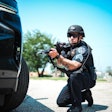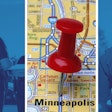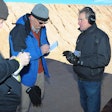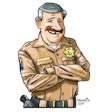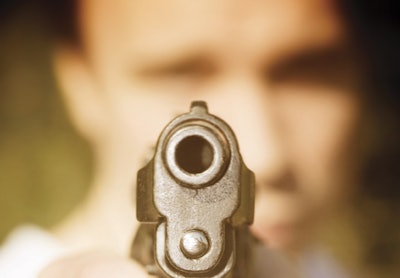 Photo courtesy of iStockphoto.com.
Photo courtesy of iStockphoto.com.
When the black BMW pulled into the Billings, Mont., convenience store's parking lot in the early morning hours of May 24, it was followed by a city police cruiser. The officer behind the wheel of the cruiser, Sgt. Shawn Finnegan, thought he'd recognized one of the BMW's occupants as a criminal whose frequent flier miles with local law enforcement had netted him an active $50,000 warrant.
Finnegan caught up to one of the car's occupants as he stepped through the store's front door.
"Isn't that Michael Brandon?" Finnegan asked, indicating the man in the Dallas football jersey who'd already disappeared inside the store. The BMW's passenger shook his head.
"I don't know who you're talking about," he said, and moved toward the Bimmer.
But the man's dismissive attitude suggested to the sergeant that he'd known all too well what Finnegan was talking about. He decided to wait for backup outside the store while the man he believed to be Brandon shopped inside.
Backup arrived in the form of Officer Steve Hallam. Once briefed by Finnegan, Hallam accompanied the sergeant through the store's doors. Inside, the two officers forked off from one another and went down separate aisles of the store in search of the suspect.
When it came to mysteries, their quarry had fewer to solve and more to worry about. Since entering the store, Brandon, 29, had become well aware of the sergeant's intrigue as to his identity and the implications of a second officer arriving at the store. The question was what to do about it. With a cell phone to his ear, he paced back and forth along a bank of refrigerated displays at the rear of the store in deliberation. As the officers entered the front doors, Brandon made his move. He crouched and retrieved a handgun from his waistband.
Diving for Cover
Hallam made his way past the endcaps of the aisles, staring down each as he passed. As he rounded the last, he spotted a man. The man standing less than 15 feet away from him matched the description of Brandon given him by Finnegan. But that wasn't the first thing that registered on Hallam's visual cortex. It was the Smith & Wesson 9mm Sigma that the man was pointing directly at his face.
Hallam pedaled backwards. Brandon opened fire. Bullets tore into the store fixtures behind him as Hallam dove into the adjoining store aisle.
Behind Hallam, a patron reaching into an adjacent cooler was narrowly missed by one of Brandon's rounds. Darting back around the corner from which he'd come, Hallam stumbled and fell. He wasn't alone. In response to the gunfire, Finnegan pivoted so violently that he'd broken a bone in his foot.
Brandon turned and darted in the other direction, sprinting through the store's front doors as the officers picked themselves up and went after him. As though sensing their chase, Brandon blindly pointed the gun back over his shoulder and continued to fire at them.
On most nights the officers could have kept the 5-foot 8-inch, 180-pound Brandon in range. But Finnegan's broken foot slowed them down. Splitting up being out of the question, they did the smartest thing they could—got assistance rolling as they watched the shooter flee across the parking lot.
A growling yowl of sirens filled the night. The two officers began coordinating containment on a man who in a matter of seconds had gone from being a felony burglary suspect to a man now wanted for the attempted murder of a police officer.
Manhunt
Sgt. Shawn Mayo had been away from his car walking patrol in the downtown area when he heard the call. Sprinting back for his car, he covered the remaining distance to the store in good time and upon his arrival immediately began assisting in coordinating a containment perimeter on the suspect. A lieutenant and additional personnel responded shortly thereafter, and with the crime scene locked down, a search group was organized to find the suspect.
Among those selected to search for Brandon were Officer Mike Yarina and Officer Marc Snider. Two blocks away from the store, the duo spotted an open side door at the Dude Rancher Lodge. Knowing the door was usually locked, they decided to take a look inside.
They quickly made their way through the motel toward the front desk. In the motel lobby they found two females in the process of renting a room. Nearby, a sullen male stood in the doorway to the ladies restroom.
The officers asked the man what he was doing there, but finding his response unintelligible told him to go back to his room because they were looking for a suspect. Checking the adjacent men's room door, they found it was locked.
Yarina and Snider called Sgt. Mayo and advised him of their observations. Mayo instructed the two to back off and wait for his arrival.
An ice machine and a soda machine occupied the hallway facing the bathroom door. Yarina and Snider took cover behind them as they covered the restroom door. Their choice of cover was as timely as it was prudent.
Suddenly the restroom cracked open and shots rang out.
The officers returned fire. Yarina squeezed off rounds from his .40 caliber Glock. Snider pumped out shotgun pellets from his 12-gauge Remington Model 870.
Out in the parking lot, Mayo heard the gunfire. He grabbed his SWAT-issued short-barreled entry carbine, and entered the lobby as quickly as sound officer safety tactics would permit.
Inside he found Snider in the lobby covering the entrance to a short hallway. Unable to see Yarina, he assumed his peer was down.
"Where's the shooter?"
Snider motioned with his shotgun toward an alcove leading to the men's restroom, a mere six yards away from where they stood.
No sooner had Mayo's eyes locked onto the alcove than he heard a war cry emanate from beyond the restroom's round-perforated door. A split-second later the door flew open and the suspect charged around the corner of the alcove toward them, gun raised.
Mayo fired off two quick rounds from the patrol rifle he held in the low ready position, striking the suspect in the chest. He fired two more rounds that soared above Brandon's head as the man began to fall. Brandon's body smacked the ground just two yards away from the officers.
Snider and Mayo pinned Brandon down on the ground as Yarina came around the corner and got him handcuffed.
EMS was already in the area in response to the initial officer-involved shooting, so the officers didn't have to wait long for medical assistance to arrive. It didn't matter. Brandon was pronounced dead on arrival at the local hospital.
Tactics, Training, and Faith
Medical checked out the two officers. They returned to city hall while the lieutenant took care of securing the scene and following up with detectives.
Mayo notes that as bad as things got, they could have gotten much worse. One thing that neither Yarina nor Snider was aware of at the time of their contact with the girls in the lobby was that the two girls had been in the company of Brandon and the second male at the gas station at the time of the initial confrontation. More than that, they had not known that one of the women had a police scanner app on her phone, was listening to all of the radio traffic that was being broadcast, and was relaying that information to the suspect as he hid inside the restroom. This no doubt accounted for Brandon's desperate exit and accompanying war cry.
The Billings PD may be the largest municipal law enforcement agency in the state of Montana, but with only 140 sworn personnel, it has to work closely with neighboring law enforcement agencies. This situation was no exception. And those agencies provided more than just manpower. For example, the Yellowstone County Sheriff's Office provided night vision to search around buildings that were heavily vegetated and allow the officers to move about more safely.
Throughout the final confrontation with Brandon, each officer was thinking tactically, incorporating available cover and concealment and considering force options. When Officer Snider's shotgun ran dry, it might have been more effective for him to transition to his handgun, but he knew his shotgun was a much more powerful weapon so he chose to reload to get it back up and running.
When the suspect ran out of the bathroom, Officer Yarina's gun ran dry. He did a good job of moving backward while doing a speed reload and keeping himself a small target as the suspect continued to fire at him. His training kicked in when he realized that his gun locked open and he knew to keep moving while he reloaded so he wasn't standing there being a target.
Still, Mayo notes that officers would be remiss if they didn't go back and re-examine the measures taken and criticize themselves. In his case, he notes that he could have taken another second to grab something in addition to his rifle.
"All Billings PD officers are issued a ballistic response kit," Mayo explains. "When I got out of my car I was conscientious in grabbing the rifle but forgot to grab my kit, which also holds extra magazines for the rifle. It turned out that I didn't need the kit, but it would have been good to have it."
As it was, the Hornady A-Max ammo he deployed performed flawlessly. "Tremendous stopping power," Mayo says. "Once the rounds hit the suspect, all of the power transferred to the suspect. But those that went into the walls did not penetrate deeply."
During the initial exchange of gunfire between Brandon and officers Yarina and Snider the officers' rounds crisscrossed right and left of the unseen suspect in a "V" pattern through the door crack.
"Not a criticism, just a reality," notes Mayo. "It's difficult to hit what you can't see."
Having been in a previous shooting and having read Lt. Col. Dave Grossman's books, "On Killing" and "On Combat," Mayo had some idea what to expect both during the incident and after. He was less surprised to have experienced auditory exclusion when he shot his rifle at the suspect than he was appreciative of the silence. "A .223 is very loud in an enclosed space," he explains.
Mayo points to training as the key to the officers surviving the shootout. "Training is paramount to an effective response to anything," reminds Mayo. "If you don't train, you can't effectively respond. You do not rise to the occasion, but fall back to your level of training."
Mayo had a lot of training through his time on the SWAT team, which had also been through the active shooter course. He'd also served as an instructor for an active shooter course for his and other agencies. Having had that experience, training, and knowledge, as well as providing critique and help to other officers over the years, was instrumental.
He wasn't worried about himself during the incident. He has a strong faith in Jesus Christ and is totally secure in his safety.
"If I get shot and die, then that's the plan. I don't want it to be the plan, but I'm not worried about my salvation. To be effective, I can't be worried about what's going to happen. I just do what needs to be done," he says.
After the incident, Mayo was sitting in the sergeant's office reflecting on what had happened. He thought to himself that he should be praying and thanking the Lord for the safety of his people. Some officers have small rituals they go through before going on duty. Mayo doesn't do that. He prays when it's necessary and when he feels moved, but it's not a ritual.
That night before he went on duty, he found himself alone in a quiet locker room and decided to say a prayer to ask the Lord for safety and to keep his people safe.
Mayo continues to serve with the Billings Police Department.











